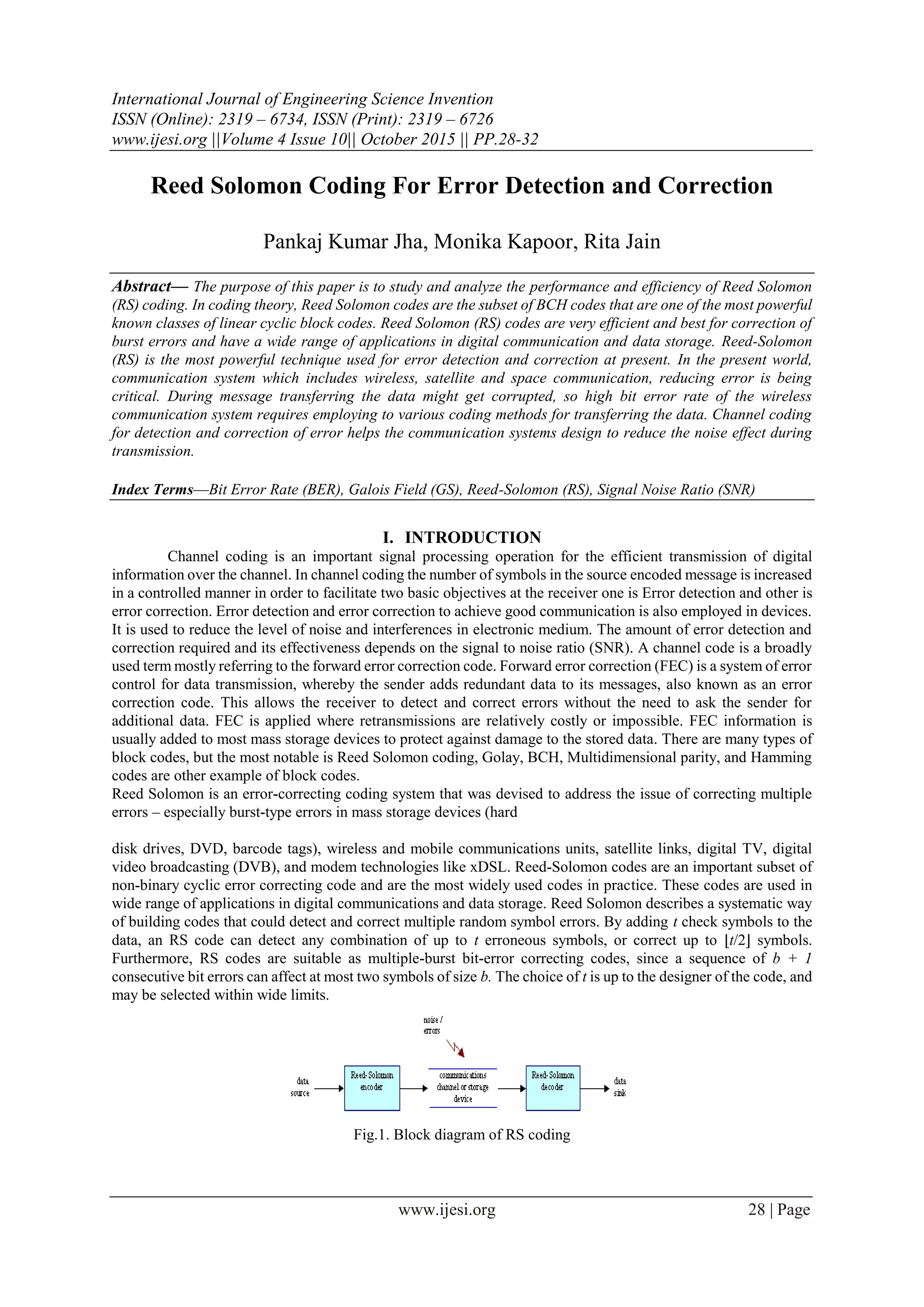This document discusses Reed-Solomon coding for error detection and correction. It provides an overview of Reed-Solomon codes, including that they are a type of linear block code well-suited for correcting burst errors. The encoding and decoding processes are described at a high-level, involving the generation and root-finding of polynomials over Galois fields. Applications mentioned include data storage, satellite communications, barcodes, and CD audio. In summary, the document provides a technical introduction to Reed-Solomon coding, the encoding and decoding algorithms, and common uses in digital communication and storage systems.




![Reed Solomon Coding For Error Detection…
www.ijesi.org 32 | Page
VII. CONCLUSION
This paper presents clear understanding of Reed-Solomon codes used in error detection and correction. RS are very
powerful non-binary cyclic codes and are used mainly for burst errors. There are different applications of
REED-Solomon codes such as data storage, satellite transmission, bar code etc. and the main component of a
Compact Disc is RS code. The main purpose of this paper was to study the Reed-Solomon code encoding and
decoding process and also different step for decoding process has been discussed. The error probability for RS
code shows that the BER performance also improves for large block length and shows a poor BER performance for
lower SNR as the SNR value increases the curve becomes steeper.
REFERENCES
[1] Carl Eklund, et.al. "WirelessMAN: Inside the IEEE 802.16 Standard for Wireless Metropolitan Area Networks,‖ IEEE Press, 2006.
[2] Hagenauer, J., and Lutz, E., ―Forward Error Correction Coding for Fading Compensation in Mobile Satellite Channels,‖ IEEE
JSAC, vol. SAC -5, no. 2, Feb 1987, pp. 215 -225.
[3] J. Jittawutipoka, J. Ngarmnil, ―Low complexity Reed Solomon encoder using Globally optimized finite field multipliers‖ , IEEE
Region 10 conference, Nov. 2004.
[4] High-speed VLSI Architecture for Parallel Reed-Solomon Decoder", IEEE Trans. On VLSI, April 2003.
[5] H.M. Shao, T.K. Truong, L.J. Deutsch, J. Yuen and LS. Reed, ―A VLSI Design of a pipeline Reed-Solomon Decoder‖, IEEE Trans.
Comput., vol. C-34, no. 5, pp 393-403, May 1985
[6] J.L.Massey, ―Deep Space Communications and coding: A Match Made in Heaven,‖ in Advanced Methods for Satellite and Deep
Space Communications, Lecture Notes in Control and Information Sciences, Volume 182, Berlin: Springer-Verlag, 1992.
[7] Sanjeev Kumar, Rajni Gupta, ―Bit Error Analysis of Reed-Solomon Code for Efficient Communication System,‖ International
Journal of computer Applications (0975 – 8887) Volume 30- No. 12, September 2011.
[8] Wicker, Stephen B., Bhargava, Vijay K, ―Reed-Solomon Codes and the Compact Disc‖, IEEE Press ISBN 978-0-7803-1025-4.](https://image.slidesharecdn.com/e410028032-151202102113-lva1-app6892/75/Reed-Solomon-Coding-For-Error-Detection-and-Correction-5-2048.jpg)